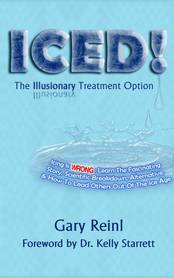 Iced! The Illusionary Treatment Option By Gary Reinl USA, 2013 166 pages www.garyreinl.com "Easy to read, (potentially) difficult to digest" is how I would best describe this book. Several years ago, I had contacted two well-respected colleagues and bluntly asked them what, in their experience, was the most effective method for improving recovery post-injury. After a short discussion it was made clear that I had to speak an individual named Gary Reinl. Well I did and today I can confidently say that I have a better understanding of the potential negative role that ice can play on post-injury healing and recovery. Long thought to be the first and possibly most important protocol a therapist must apply to an injured athlete, icing is now seldom if at all pulled from my toolbox thanks to Gary. For those of you who have yet to meet Mr. Reinl, watch his interview with Kelly Starrett, and/or are still frequently using ice and cryotherapy in the acute management of sports injuries, I highly suggest you read Iced! As I mentioned above, this book was easy to read and for me, a nice break from most clinical textbooks. In fact, I was able to breeze through the book on my return flight to and from a recent to Portland (approximately 5 hours). As I also mentioned above, this book may potentially be difficult to digest for some. Again, traditional clinical wisdom tells us to use ice and cryotherapy post-injury but since inflammation is a critical early step in the healing process of muscle and tissue injuries, it is very important that we instead try to facilitate this natural process...and speed it up (again, the whole process) if necessary. There is no question that Gary is a great story teller. And this book reflects exactly that. In a coherent and progressive manner, Gary uses a first person narrative to tell us why we started applying ice in the first place, how he came to the epiphany that icing may not be ideal, and how he directly and indirectly influenced the same thought processes of most North American professional teams' training staff. Gary also devotes a chapter to the three phase healing process and summarizes the current state of the literature on the use of icing in injury. What is made clear is that there are actually no high level research studies that unequivocally conclude that icing speeds up the healing process and that some studies even state that icing can delay the healing process. Rather than leaving the reader with no alternative to ice, Gary graciously provides us with examples of protocols that have anecdotally worked for him and his clients/athletes following injury. Now certainly, we would have to do some critical thinking ourselves, but his examples really make it simple for the reader to understand the rationale behind muscle contraction and injury recovery and subsequently apply similar principles. With all that said, does it mean that icing and similar therapies are completely unnecessary? Gary does stress that in a life or death scenario (i.e. amputation, injury in the woods, etc) icing would certainly be a viable option. However, there has been some valid research with respect to the use of ice baths to upregulate the sympathetic system in hyperparasympathetic states. Remember though, such scenarios are separate from acute injuries. In my opinion, I think this book would be relevant for all stakeholders in sport. From athletes and coaches to medical staff and front office personnel, Iced! is a welcomed myth-buster that in due time, will no doubt help athletes recover from injury in a more timely and efficient manner.
0 Comments
Leave a Reply. |
